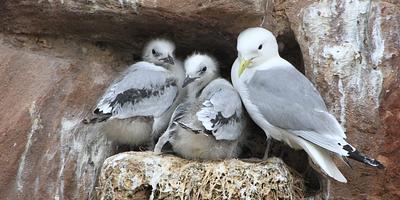
Dunbar Harbour
Dunbar kittiwake colony
The historic castle and harbour in the coastal town of Dunbar supports a breeding colony of black-legged kittiwakes. Kittiwakes are beautiful gulls with a bright yellow beak, distinctive black legs and black wing tips which look as though they have been dipped in ink. They spend most of their time at sea only coming ashore to breed between February and August.
Dunbar kittiwake colony
Our interactive wildlife camera at Dunbar harbour provides a great opportunity to view breeding black-legged kittiwakes which nestle into the ruins of Dunbar castle, and the surrounding rocks and cliff ledges, around Dunbar harbour. You may also get glimpses of harbour life with fishing vessels, leisure boats and activities, as well as marine wildlife such as eiders and grey seals.
Kittiwakes spend most of their time at sea but come ashore from February until August where they gather to breed, perched somewhat precariously, on narrow cliff ledges. The air around these breeding colonies is filled with the loud “kit-ti-wake” call. Kittiwakes create shallow nests of seaweed, moss and other plant material that is normally bonded together with mud or clay. You will often see evidence of cut-offs of fishing ropes from around the harbour incorporated as nest material too. You can find out more of the life-cycle of a kittiwake in our species profile. Over 70% of the British breeding population is found in Scotland but these beautiful gulls have suffered significant declines since the mid-1970s. They are now listed as vulnerable (red listed) by the IUCN.
Thanks to Dunbar Harbour Trust for their continued support for the camera and our engagement activities and to Valencia Communities Fund for supporting the upgrade of the camera.
If the live screen appears black or frozen, we may be experiencing technical problems with the camera or in the winter, as our cameras are solar powered, there may be insufficient power. We apologise for any inconvenience.
